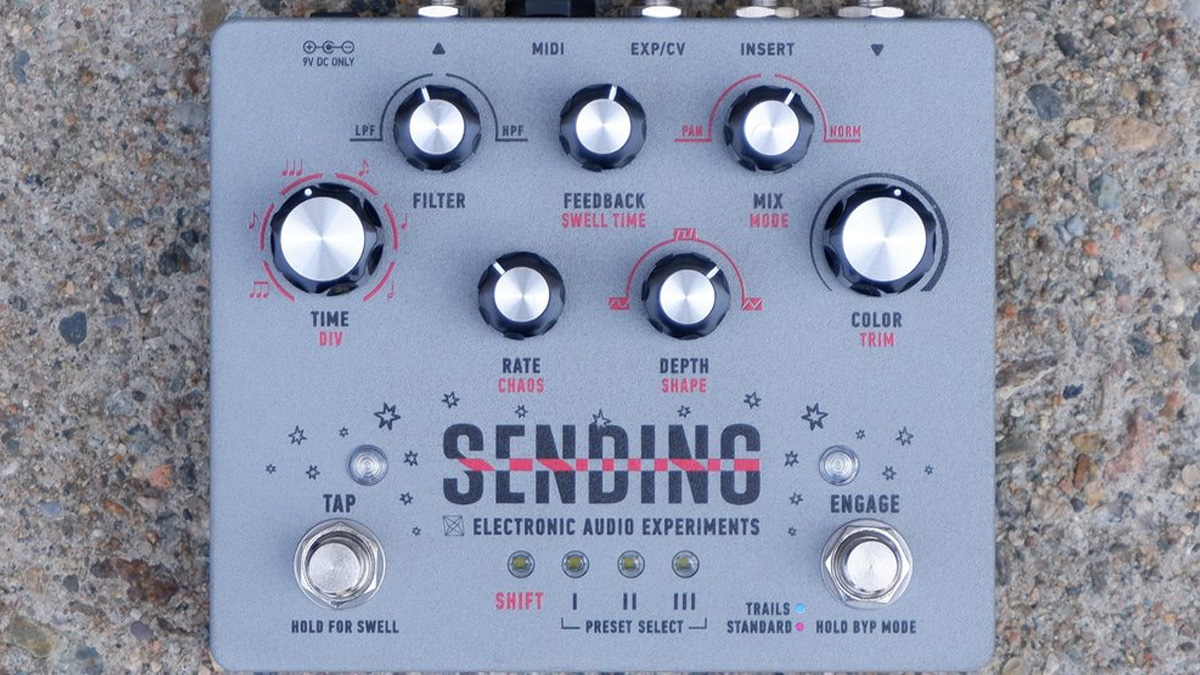
Electronic Audio Experiments has just announced the release of a new delay pedal that JHS Pedals’ supremo Josh Scott – and others – have heralded as a masterpiece. It is called the Sending V2, like its predecessor, it is an analogue delay, but despite the V2 designation this is an all-new design and one that was so ambitious it took its creator to the brink.
In the manual, John Snyder, the mastermind behind the Boston-based Electronic Audio Experiments, likens the arduous design process to Schubert’s 8th. There is one crucial difference, though, Snyder finished his project. And now, come noon (EST) on Friday 18 July, it goes on sale.
The asking priced, $649, is not to be sniffed at but this is a lot of pedal, featuring an analogue delay based around a pair of MN3005 BBD chips, and controlled by a 32-bit, 100MHz digital processor that gives you presets and MIDI control over ever parameter.
Sending V2 features a discrete input preamp that can serve as a tone-sweetener, adding a little warm saturation to complement the delay lines. You can set its delay time up to a full one second without any clock noise, but EAE says you can push it further “for compelling sonic degradation”. EAE offers a comprehensive set of controls here.

This is a dual-footswitch design with both footswitches pulling double shifts. The Tap Tempo footswitch can of course set the delay time but hold it down for a swell effect. When depressed, adjust the swell time via the Feedback dial. The Engage footswitch turns the effect on and off, and if you hold it down you can toggle between trails and standard bypass modes.

• Boss DM-101 Delay Machine pedal
The best analogue delay pedal currently available anywhere and a future classic from Boss. The blend of glorious sounds with cutting-edge control and functionality means this could be your do-it-all delay.
The Time knob allows you to dial in delay times from 25ms to a second, with a secondary feature allowing you to cycle through tap tempo divisions. Feedback controls how much of the delayed signal goes back through the input, and like the best analogue delays, you can send the Sending V2 into self-oscillate at its extremes. EAE says the taper of the pot makes it easy to dial in an infinite bed of echoes before you get to the full-on self-oscillating madness.
The Mix control sets the blend between wet and dry signals in its default PAN mode – but in Norm mode the dry level is fixed and you dial in how much of the delayed signal you want to hear. There is a dual-mode feedback filter that can apply a high or low-pass filter and take give your repeats “deep pulses or dub-style bright echoes”. Setting the filter dial at noon takes it out your signal.
The Rate knob, meanwhile, adjusts the frequency of the delay time modulation, and has an alternate ‘Chaos’ mode that randomises the LFO. Depth adjusts the LFO’s amplitude and has a secondary function that allows you to choose from sine, square and triangle LFO wave shapes.
Finally, the Color knob controls the input preamp, and is described as having “three effective regions”; the first dials in a little warmth; the second can add a bit of hair to the delayed signal so your repeats begin to break up; while the third applies this warm drive to both wet and dry signals.
That Color dial, too, has a secondary function, adding 6dB either way as a volume trim. What is also quite neat about this design is that, in Trails mode, you can use the Sending V2’s preamp and adjust it via the Color control to leave on as an always-on effect to add some extra hot sauce to your electric guitar tone.

The jacks are mounted on the top of the pedal and include two 1/4” connections for your instrument cable, a 1/4” EXP/CV input for hooking up an expression pedal, a MIDI input, and a TRS loop so you can get creative and introduce external pedalboard goodies to the feedback loop.
The pedal takes 9V DC and draws 380mA. EAE recommends a high-current pedalboard power supply rated 400mA or more. For more information, head over to Electronic Audio Experiments.
Orders open at noon EST, Friday 18 July. Even at $649, we would expect initial runs to sell out, but the Sending V2 is not limited edition. If they sell out, more will be on the way.







